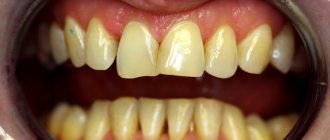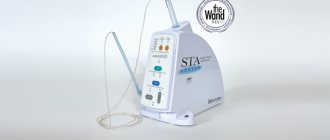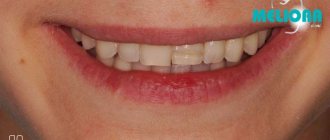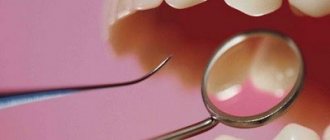Modern restorative techniques for restoring dentition in the oral cavity cannot be imagined without innovative technologies using metal-free ceramics. Metal-free ceramics have almost unlimited possibilities to recreate teeth and restore a beautiful smile, at any stage and degree of their destruction or their complete absence.
Frame structures, crowns, traditional and adhesive types of dentures, any type of onlays, inserts or veneers made from metal-free ceramics are distinguished by high-quality aesthetics, naturalness, and the consistent texture of real teeth.
Types and main characteristics
The main division of bridges is based on material. Highlight:
- porcelain, which is relatively fragile and is rarely used for chewing surfaces;
- all-zirconium, characterized by high strength and long service life;
- crowns made on the basis of zirconium, but with ceramic coating (considered the most aesthetic, and at the same time very durable).
It’s difficult to say which option is the best. The choice must be made individually, and the client’s teeth must be under special control so that the best result can be achieved.
Application area
Thanks to the high strength of the material, it is now possible to solve any problems related not only to prosthetics, but also to restoration of teeth. That is, specialists can eliminate the appearance of a small chip on the enamel, and even “grow” an artificial tooth. This is especially true for patients suffering from metal allergies.
If you need to restore the color and shape of teeth (especially the front teeth), then innovative material will help here too. Installation of structures made of metal-free ceramics, the price of which can vary, is the best solution to the existing problem. At the moment, the production of dentures for all types of teeth has been mastered.
Pros and cons of metal-free crowns
The main advantage of the design is its high aesthetic characteristics. The fact is that the material has the same degree of light refraction as the enamel of a healthy tooth, so it is almost impossible to distinguish a dental crown from healthy chewing surfaces even with very careful examination.
In addition, crowns and dentures made of similar material have a high shock-absorbing capacity (which reduces the load on the periodontium and makes them indispensable for implant prosthetics), wear resistance, do not change their color, fit perfectly to the gums (and, as a result, prevent infection and caries development)
Until recently, crowns made of metal-free ceramic material were installed only on the front teeth to solve aesthetic problems, however, with the advent of new casting technologies, dental crowns and dentures using similar technologies are successfully used for dental prosthetics.
The disadvantages include the high cost of prostheses. Not only does the material that will serve as a replacement for extracted teeth cost more, but also the equipment to work with it and personnel trained to use the equipment. As a result, the cost of care and installation increases greatly.
Reviews
The high cost of all-ceramic crowns and the lack of a 100% guarantee that they will never crack makes potential clients wonder whether they should give preference to, although less aesthetically pleasing, reliable and proven metal-ceramics.
If you have had metal-free zirconium oxide or ceramic crowns installed, please tell us if they met your expectations. A short comment at the bottom of this page won't take much of your time.
If you find an error, please select a piece of text and press Ctrl+Enter.
Tags crowns fixed dentures
Did you like the article? stay tuned
No comments yet
Metal-free ceramics or metal ceramics
Unlike metal-ceramic crowns, where a metal cap is used as a base, followed by lining with ceramic mass, in a metal-free ceramic crown, aluminum or zirconium oxide is used as a frame, onto which ceramic mass is applied.
Another advantage of the design over metal-ceramics is its bioinertness, i.e. Completely harmless to the body and no allergic reactions.
CL-III (high strength crystalline materials)
The peculiarity of this group is the content of a small amount of crystals in the material or their complete absence. Manufactured industrially. The main difference from previous types of ceramics is the formation of a certain connection between the main matrix and the crystals. Classified into two types:
- CL-IIIa. The manufacturing principle is to form a porous block, which is filled with a molten phase (lanthanum aluminosilicate glass). This liquid fraction fills all the pores, as a result of which significant strength of the ceramic is achieved. Despite this advantage, such prostheses began to be used less and less, and they were replaced by 100% polycrystalline ceramics (group CL-IIIb).
- CL-IIIb. Crowns are made from polycrystalline ceramics, which consists of aluminum oxide. Recently, preference has been given to products made from zirconium dioxide. It is used for prosthetics of single teeth, bridges, or in cases where bonding is quite difficult.
To ensure high quality fixation of crowns, it is recommended to use materials of group CL-III or CL-IV (metal-ceramics). This is because the fabricated structures can be secured using a direct protocol. But in the case when zirconium material is used as a prosthesis, special attention should be paid to the interaction with the teeth of the opposite jaw.
High-strength crystalline materials should be applied with a thickness of 1.2–1.5 mm. It depends on the required shade. Products made from CL-III group compounds are an alternative to metal ceramics.
How are crowns made?
To replace a tooth, you need to have a crown made in a medical clinic. To do this, there are three stages:
- the doctor, in the office, makes a cast of the jaw so that the position is clear, and transfers it to the laboratory;
- the equipment scans the impression and creates a model required for specific teeth;
- The implant is automatically made from the necessary materials.
Some clinics use more modern equipment to work with teeth. Which? An intraoral scanner, with which you can avoid using impression material, that is, skip the first step of working with teeth when making new bridges.
Content
- Peculiarities
- Application area
- Manufacturing process
- Advantages
One of the most popular areas of dental prosthetics today is the use of metal-free ceramics, which was invented relatively recently. Every person has a desire to have teeth identical to the real ones, and new technology facilitates the production and allows the installation of crowns made of metal-free ceramics, which has become another reason for the rapid development of aesthetic dentistry.
What types of prostheses are there?
A similar approach in prosthetics is used as ceramic inlays and onlays (inlays, onlays), veneers (ceramic overlays on the front part of the tooth), dental crowns and dentures. Currently, in dentistry, prosthetics using ceramic products without metal are more often used in the manufacture of fixed dentures, however, in some cases, the technique can also be used in the manufacture of removable dentures (for example, when removable dentures are fixed using microimplants).
Group CL-I (powder/liquid)
These types of ceramics in dentistry consist of powdery and liquid materials. Their main component is silicon dioxide, which is contained in the glassy mass. Depending on the ratio of these components, the crown will have a more or less pronounced crystalline structure.
The CL-I group includes:
- Creation Porcelain, Jensen Dental;
- Ceramco 3, DENTSPLY International;
- EX-3, Kuraray Noritake Dental, Inc.
Dentures can also be made from feldspar, which contains barium, potassium, calcium or sodium. Initially, dental crowns were made from this material.
Options for aluminosilicates used:
- VITA VM 13, VITA Zahnfabrik;
- Vintage Halo, Shofu.
The production of prostheses of the CL-I group is carried out manually. They are used primarily for restorations that preserve most of the tooth, since the material is quite fragile and transparent. Nevertheless, it is feldspars that make it possible to achieve the best results when correcting the structure of a damaged crown.
Aluminosilicates are applied to the enamel in a thin layer of 0.2−0.3 mm. As a rule, ceramics from the CL-I group are used to restore incisors and canines, and less commonly, molars and premolars. Although the ceramic mass used for teeth is quite fragile, under adequate load the probability of its damage is very low.
Stages of prosthetics
Teeth can be replaced with crowns in a few simple steps. Among them:
- a thorough examination of the oral cavity by a doctor, assessing the teeth, determining which implant option is best suited;
- preparation in the form of caries removal, filling, removal of teeth that cannot be treated;
- treatment on the tooth, which will become the basis of the prosthesis;
- grinding, which will become the basis of one or several in the event that bridges can be made;
- making a cast;
- preparing the ideal implant from the right components, taking into account the characteristics of the patient and his requirements;
- if the prosthesis will take a long time to be made, a temporary crown will be installed on the treated teeth, which will protect the treatment area;
- After production, you need to try on the prosthesis and, if everything is satisfactory, the doctor inserts it into the oral cavity.
It is good if, after installation, the patient appears several times for a follow-up examination, to assess the condition of the materials and how they adhere to the teeth.
The entire procedure can take on average from several hours to a couple of days, and sometimes even a month. Much depends on what kind of help the tooth needs before prosthetics, what is the general condition of the oral cavity, and whether all the components and equipment necessary for making a crown are available. If quick production is not possible, there is no need to rush, since quality is important in this work and it is not cheap.
Advantages of the clinic
Reasonable prices for services
Highly qualified specialists
Modern techniques and equipment
Treatment on credit and in installments
Price
The price depends on its material and varies over a very wide range. The status and location of the clinic also affects the price, but not to the same extent as the material.
All in all:
- The price of installing an all-ceramic crown will cost the patient from 15 thousand rubles.
- Anyone who decides to install a microprosthesis made of zirconium oxide should be prepared to part with 20-25 thousand rubles.
- The price for installing models made from E-Max material ranges from 30 to 50 thousand rubles.
- Cheaper than others are plastic crowns, which can be installed for only 1.5-2 thousand rubles.
Indications and contraindications for the use of metal-free ceramics
There are many indications for metal-free ceramic dentures to become teeth. They can be used if:
- a person is allergic to other materials, which does not allow for proper dental care and replacement;
- Canines or front incisors need to be restored;
- dark spots that cannot be removed;
- teeth require careful correction due to congenital defects;
- correction is required to obtain an even row;
- It is necessary to restore the teeth that are visible when you smile.
There are not so many contraindications for such dental care. These include acute diseases (after they subside, installation of an implant from any material is possible), pregnancy, and the habit of grinding teeth (bruxism).
The best thing is that there is no long recovery period required after the installation of dentures. The main thing is to learn the rules for proper care of new teeth and follow them carefully so that the dentures last a long time and do not cause any inconvenience.
Progress of treatment
Consultation and diagnosis
Drawing up a treatment plan
Treatment procedure
Preventive examination
Why do you need dentures?
Damaged teeth, and not only in the smile area, need to be replaced with prosthetics, and the sooner the better. Lost interdental contacts, changes in bite, tilt and displacement of neighboring teeth are only part of the problems that await a person who postpones the restoration of lost or damaged teeth for at least a year. We talk about this in detail in the section Fixed prosthetics.
In addition, solving problems that arise later will be significantly more expensive, so dentists recommend not to put off such treatment “on the back burner.”
Caring for metal-free dentures
There is nothing complicated about caring for teeth replaced with metal-free ceramic implants. The material is characterized by low capriciousness. It is worth following standard recommendations for hygienic care. It is important to avoid using paste with large particles, as they can scratch the denture. Also, you should not chew very hard foods with their help, as the prosthetic tooth may chip. After all, the density is, of course, high, but not infinite.
With proper care of teeth replaced with dentures, the latter will last 15 or even 20 years.
A solid period that fully justifies the rather high price. Sources:
- Accurate impression - Ryakhovsky A.N., Muradov M.A.
- Dental implantology. Introductory course - Kutsevlyak V.I., Grechko N.B.
- Dental implantation (surgical aspects) - Robustova T. G.
- Dental implantation. Success criteria - Zhusev A.I., Remov A.Yu.










